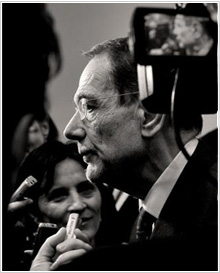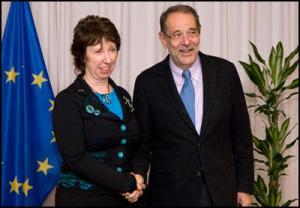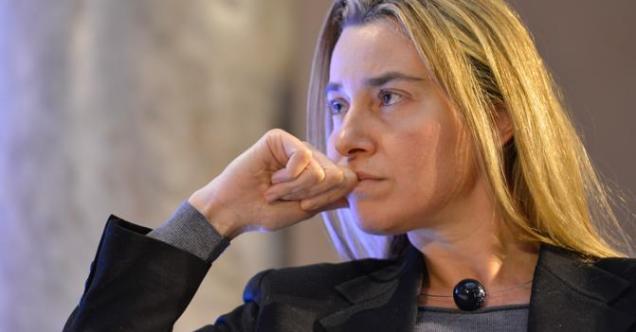On November 1st, 2014, the transfer of power from Catherine Ashton to Frederica Mogherini was finally official. Federica Mogherini is the third High Representative (HR), as well referred as EU foreign minister, in EU history. The first HR, Javier Solana of Spain, was appointed in 1999 and remained at the helm for two mandates (1999-2009), followed by Catherine Ashton of the UK for one mandate (2009-2014), to now Federica Mogherini of Italy (2014-).
Before drawing some expectations on what the EU under HR Mogherini may look like, one should reflect on the transition of power from one High Representative to another: Solana to Ashton to Mogherini. Out of the three High Representatives, Mogherini seats comfortably behind Solana in terms of promising situations, meaning EU Member States’ willingness to commit to EU foreign affairs, economic position of the EU, and global forces. Catherine Ashton received the worst situation possible once appointed as HR in 2009. Considering the domestic, regional and international situations, it would have been very difficult for any appointee to make it into a successful tenure.
The Position and Role of the High Representative
The position of High Representative was established at the Treaty of Amsterdam in 1997  and the first High Representative for the Common Foreign and Security Policy was appointed in 1999 after the European Council meeting of Cologne (for more in depth analysis on the position of the HR refer to these books, here and here). The article J.8.3 of the Amsterdam Treaty mentions the position of HR and states that the Presidency will be assisted by the HR. The description of the job requirements was very broad, as the HR ought to contribute with assistance of the Council to the “formulation, preparation, and implementation of policy decisions” on foreign and security policy matters (Official Journal of the European Union 2007: Article J.16). The HR was supposed to increase the cooperation between the various actors in Common Foreign and Security Policy (CFSP), bring coherence in the rotating processes of the six-month presidencies, and to make the EU a more visible international actor.
and the first High Representative for the Common Foreign and Security Policy was appointed in 1999 after the European Council meeting of Cologne (for more in depth analysis on the position of the HR refer to these books, here and here). The article J.8.3 of the Amsterdam Treaty mentions the position of HR and states that the Presidency will be assisted by the HR. The description of the job requirements was very broad, as the HR ought to contribute with assistance of the Council to the “formulation, preparation, and implementation of policy decisions” on foreign and security policy matters (Official Journal of the European Union 2007: Article J.16). The HR was supposed to increase the cooperation between the various actors in Common Foreign and Security Policy (CFSP), bring coherence in the rotating processes of the six-month presidencies, and to make the EU a more visible international actor.
Until the Treaty of Lisbon (2009), the position of the HR did not evolve institutionally speaking. Javier Solana made his marks all over the position during his tenure. With Lisbon, the new position became the High Representative of the Union for Foreign Affairs and Security Policy and Vice-President of the European Commission. The Lisbon Treaty made the position of HR more complex and as well cross-institutional, as the HR sits now at the Commission and at the Council, whereas before the Treaty of Lisbon, the HR was only sitting at the Secretariat of the Council. The position of the HR is now the bridge between a supranational institution, the Commission, the Member States, the Council, and the institution at the HR’s disposition, the European External Action Service (EEAS). The most important change in the position of the HR is its double-role, supranational and intergovernmental all at the same time. As opposed to her predecessor, HR Mogherini has announced her moving from the EEAS building to the Commission’s building, wherein she will be residing. The Treaty of Lisbon made the position of the HR one of the most powerful and visible figure in the Union.
From Ashton to Mogherini
A vast literature, mostly from media and think tanks, have demonstrated, since her appointment, how Catherine Ashton has been a weak HR and certainly not very savvy in dealing with foreign affairs. Cathy Ashton even describes herself as the “accidental diplomat” (O’Connor 2010). HR Ashton certainly scored some late successes with the agreement in Kosovo (despite the recent scandal over the EU mission in Kosovo) and Iran. For the rest, HR Ashton has been invisible and quiet. As compared to Federica Mogherini, Catherine Ashton took the helm of European foreign policy at a very difficult time. One should recognize that Ashton faced three fundamental difficulties when appointed HR/VP in 2009.
First, the world markets were at their lowest after the collapse of the global financial markets in 2007. The Eurozone was already feeling the tension and several EU Member States were already showing serious signs of weakness such asPortugal, Ireland, Italy, Greece, and Spain, formerly known as the PIIGS. The future of the Union looked very bleak at that point and many thought that neither the EU nor the Euro would survive the crisis. The financial crisis, and its consequences on the eurozone, was the first real challenge ever faced by the EU. Many realized the degree of incoherence, unpreparedness in the design of the Union and its monetary union. Ultimately, the CSDP was not the priority for neither the EU nor the Member States. The Union turned into crisis-mode and let the CSDP on the side. The CSDP was after ten years of existence considered a luxury good that Member States could easily dispense themselves from, especially the European powerhouses with effective diplomatic and defense instruments. During the Solana era, Member States were committed to the CSDP experiment and were willing to spend money and contribute in terms of capabilities and humans. This was not the same under Ashton, whom had to deal with less money, less political will, and an messy world order.
Second, Ashton was being appointed right after the adoption of the Treaty of Lisbon in December 2009. The Treaty of Lisbon changed a lot the EU in terms of foreign and security policy. First, the Common Foreign and Security Policy (CFSP) – or foreign policy – and the European Security and Defense Policy (ESDP) – or European defense – were merged into the Common Security and Defense Policy (CSDP). Second, the Treaty of Lisbon established the European External Action Service (EEAS). Cathy Ashton had one year to design a new institution and make it operational. Third, the position of High Representative for Common Foreign and Security Policy was transformed into a double-hatted position, the High Representative of European Union for Foreign Affairs and Security Policy / Vice-President of the European Commission (HR/VP). Prior to Ashton, the HR was simply part of the Secretary of the Council of the EU, now the HR is not only leading a new body, the EEAS, and chairing at the Commission. The double-hatted position merges two contradictory institutional forces, inter-governmentalism and supranationalism.
Las but not least, Cathy Ashton took over European foreign policy after its first and very successful HR Javier Solana. Javier Solana, a savvy Spanish politician, was prior his appointment at the helm of European foreign affairs in 1999, Secretary General of NATO from 1995 to 1999. During his leadership at the head of the Alliance, he oversaw the massive air campaign over Kosovo in 1998 and demonstrated on the international stage his savviness in working with Europe and the US. During his time at the head of European foreign policy, he was the person that pushed the ESDP from its paper-status into a civilian-military instruments seeing its first action in 2003. He has as well axiomatic during the nuclear negotiation with Iran in 2002-03, known as the EU3+1. The +1 being HR Solana, which rose the question of knowing if Solana was speaking in the name of Europe, or simply being an intermediary between the EU3 and the rest of the Union. Last, Solana finally was important in answering Kissinger’s question, “what is the phone number of Europe?”
appointment at the helm of European foreign affairs in 1999, Secretary General of NATO from 1995 to 1999. During his leadership at the head of the Alliance, he oversaw the massive air campaign over Kosovo in 1998 and demonstrated on the international stage his savviness in working with Europe and the US. During his time at the head of European foreign policy, he was the person that pushed the ESDP from its paper-status into a civilian-military instruments seeing its first action in 2003. He has as well axiomatic during the nuclear negotiation with Iran in 2002-03, known as the EU3+1. The +1 being HR Solana, which rose the question of knowing if Solana was speaking in the name of Europe, or simply being an intermediary between the EU3 and the rest of the Union. Last, Solana finally was important in answering Kissinger’s question, “what is the phone number of Europe?”
Yes, Cathy Ashton was not the best HR/VP that European experts were dreaming about. But she embodied what the powerful EU Member States wanted, a leaderless HR/VP shifting the EU from a risk-taking EU into a risk-averse EU. EU Member States, especially France, Germany and the UK, wanted in 2009 to avoid another Solana and settled on the appointment of Ashton. For her defense, as demonstrated above, her set of cards could not really allow her to do anything positive. During her mandate, she illustrated herself more as an administrator than a strategic leader. Her clear achievement, though, is the EEAS, that she was able to create and implement in one year.
A Welcome’s Note
 As opposed to Ashton, Mogherini’ situation is much more promising and could allow her to be an effective HR/VP. She embodies a new generation of European leaders and is from Italy, a founding Member State, that wants to redeem itself after the years of crisis. Mogherini’s experience in foreign affairs is certainly greater than Ashton’s, but lesser than Solana. It will be interesting to see what Mogherini decides to focus on: foreign policy and/or defense. Will she help in strengthening the CSDP – civilian-military instrument -? Or, would she facilitate the transition to a more NATO integrated instrument? In terms of foreign policy issues, she has several important ones in her hands (see the excellent memo by Daniel Keohane, Stefan Lehne, Ulrich Speck, Jan Techau about the challenges facing HR Mogherini):
As opposed to Ashton, Mogherini’ situation is much more promising and could allow her to be an effective HR/VP. She embodies a new generation of European leaders and is from Italy, a founding Member State, that wants to redeem itself after the years of crisis. Mogherini’s experience in foreign affairs is certainly greater than Ashton’s, but lesser than Solana. It will be interesting to see what Mogherini decides to focus on: foreign policy and/or defense. Will she help in strengthening the CSDP – civilian-military instrument -? Or, would she facilitate the transition to a more NATO integrated instrument? In terms of foreign policy issues, she has several important ones in her hands (see the excellent memo by Daniel Keohane, Stefan Lehne, Ulrich Speck, Jan Techau about the challenges facing HR Mogherini):
- short-term, ebola, the direct threat of the Islamic State (IS), and Eastern violences in Ukraine. They all represent direct threats to the security of the Union.
- mid-term, stabilizing the neighborhoods (Eastern and Southern) through economic and development assistances. Countries in Northern-Africa and Central Africa are facing serious domestic challenges that could completely destabilize the region. For the Union, it means rise of ethnic violence in Africa, illegal trafficking, rise of mass-migrations, and eventually rise of radical islamism, all these directly threatening the stability of the Union. The CSDP was created for exactly this purpose to stabilize the neighborhoods. Would it become the primary instrument for stabilization, peace-keeping, and institutional solidification?
- long-term (well beyond her tenure), the survival of European influence in global affairs and the maintenance of its strategic role side by side with new powers like China and Brazil. Ashton did not have a long-term vision, will Mogherini have one? The EU still holds a favorable position in the current global order. Its Member States are key actors in international organizations, with France and Britain at the UN Security Council, with NATO, the WTO, the IMF – Christine Lagarde of France is leading it -, the World Bank and so forth. Multilateralism has always been a core component of European global strategy, now EU Member States have to solidify and empower these international organizations in order to keep them relevant in a more multipolar system. The EU has a role to play in the 21st century, but if it does not secure a seat in this new multipolar global order, it will simply become a second/third rank power.
In any case, Politipond wishes the best of luck to Federica Mogherini. She published on the EEAS website a simple message marking her commencement and calling for a new beginning:
Today we start a new story. The next five years will be challenging, we are all well aware of the difficulties that lie ahead of us. Our part of the world is facing one of the most complex periods of our recent history, still I believe we have all the tools and the capacity to overcome these times of tensions and crisis, and build peace, stability and prosperity all around Europe. It’s up to us and we have great opportunities too. Vision, political will and teamwork can make us shape a much better future. Not only for Europe, but for the rest of the world. Today I start my mandate knowing that I can build on the good lessons we can learn from the past and counting on an excellent team: in the EEAS, in the Commission, in the Council and with all Member States. We know the next five years will be a turning point: we feel the responsibility to make the European dream come true. Generations of Europeans expect from us a new beginning. So, ready to start! Federica Mogherini (Copyright 2014 by Politipond. All Rights Reserved. This material may not be published, broadcast, rewritten or redistributed without permission).
Here is an interesting article on the transition of power from Lady Ashton to Federica Mogherini by F. Bindi: http://www.huffingtonpost.com/federiga-bindi/women-leaders-in-eu-forei_b_6086376.html
LikeLike